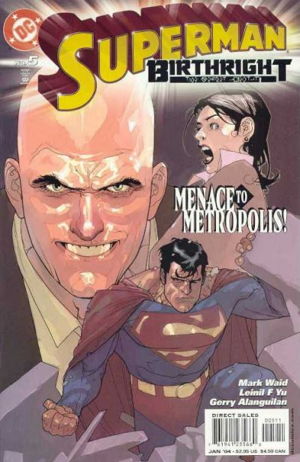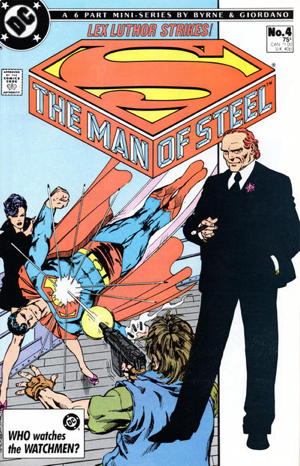Daniel’s Progressive Ruin.
Unlike my hope at the end of the last post addressing Daniel’s comment about DC and the rebooting and the continuities, I do in fact have yet another early morning appointment waiting for me as I write this the night before it. I believe that’s the last of said appointments for a while, the timing of which is unfortunately a necessity when one has a seven-day-a-week job. So let me be quick like the bunny in these responses:
“For me, the DC characters are strongest when they’re in a perpetual state of reboot and/or Elseworlds variations. Seeing a young Batman meet the Joker for the first time in stylistically and narratively different ways each time is infinitely more interesting to me than seeing 80-year-continuity Batman meet the Joker for the 368th time in their ongoing history.”
 Nearly, urgh, 20 years ago, the mini-series Superman: Birthright by Mark Waid, Leinil Yu and Gerry Alanguilan was released, retelling the early years of Superman’s life. It wasn’t intended to be part of regular continuity; rather, just a fresh interpretation of Superman’s origin by a talented creative team, unburdened by the need to be tied to anything else DC was doing with the character.
Nearly, urgh, 20 years ago, the mini-series Superman: Birthright by Mark Waid, Leinil Yu and Gerry Alanguilan was released, retelling the early years of Superman’s life. It wasn’t intended to be part of regular continuity; rather, just a fresh interpretation of Superman’s origin by a talented creative team, unburdened by the need to be tied to anything else DC was doing with the character.
I suppose what happened was that the story told in Birthright wasn’t distinct enough from mainline continuity…not branded “Elseworlds” or whatever. Not the fault of the creative team, of course, but the Superman story post-Crisis and post-Zero Hour had perhaps become nebulous enough, and distant enough from the mid-1980s John Byrne reboot, that Birthright somehow came to be considered part of the “official” origin. I believe it was this story that reintroduced the Silver Age-y idea of Lex Luthor living in Smallville when he was young, effectively de-aging the Byrne version (who’d already been de-aged via clone/deal with Neron shenanigans that I’m not going into here) from being decades older than Clark Kent to maybe only being a few years, at most.
EDIT: Please check the comments for some clarification from Mr. Waid his own self.
Daniel, I think ideally, for the purposes of DC’s maintenance of a superhero universe, having the “in-continuity” stories is fine. And your idea of having varied tellings and retellings of stories featuring the characters that don’t have to be shoehorned into that continuity is great. Does Batman: Three Jokers fit into the official, current Batman history? Will it ever be referenced outside of a Three Jokers sequel? Probably not. I know I spent a couple of posts picking at the continuity details of this story, but, really, ultimately, it doesn’t matter. It’s a standalone story you can enjoy (or not enjoy, as the case may be) as in-continuity, if you’d like, or outside of it.
 Part of the problem is that DC’s constant obsession with “fixing the universe” in most of their Big Events reemphasizes the idea that Continuity Matters, that all the pieces need to fit and be consistent. So when stuff like Birthright and Three Jokers come along, which (at least in the former, can’t say for sure about the latter) aren’t intended to be part of regular continuity but aren’t immediately identifiable as being separate from it, the readers can get it into their heads that they’re supposed to consider these stories are part of the Official Big Picture. I mean, if Batman’s not, like, a pirate in the story, or Superman’s rocket didn’t land in Norway, which is what DC has essentially trained its readership to look for when considering if a story is, biggest quotation marks ever, “real” or not.
Part of the problem is that DC’s constant obsession with “fixing the universe” in most of their Big Events reemphasizes the idea that Continuity Matters, that all the pieces need to fit and be consistent. So when stuff like Birthright and Three Jokers come along, which (at least in the former, can’t say for sure about the latter) aren’t intended to be part of regular continuity but aren’t immediately identifiable as being separate from it, the readers can get it into their heads that they’re supposed to consider these stories are part of the Official Big Picture. I mean, if Batman’s not, like, a pirate in the story, or Superman’s rocket didn’t land in Norway, which is what DC has essentially trained its readership to look for when considering if a story is, biggest quotation marks ever, “real” or not.
Look, I know most people aren’t worried to this extent about their comic book stories. I read (and am still reading) the Superman comics from the Byrne reboot ’til today, and I can draw a more or less unbroken line from what happened then to what’s going on now. Is everything entirely consistent? No, of course not…it wasn’t even before the whole Flashpoint/New 52/Rebirth hoohar. Does that bother me? Nah, not really. I tend to go on about some of the inconsistencies here on this site, but more out of amusement than outrage. As a wise philosopher once almost said, “it’s just a [comic book], I should really just relax.”
In short, if I can ever be short, DC has its readership used to the idea that continuity is paramount, and therefore every story has to “count.” Thus, doing stories that aren’t necessarily in continuity can become difficult to distinguish as such unless they contain gimmicks that decidedly make them outside the main storylines. Thus, anyone really bothered by this sort of thing, which isn’t everybody, I know, but it ain’t zero people, can find things to be confusing.
“And I think that this is part of DC’s brand management problem. I believe that there are just as many people like me who love the excitement and variation of reboots as there are people who prefer (and want to perpetuate) the never-ending 80-year soap opera. And any attempt to go in one direction or the other will inevitably alienate the other audience.”
I know DC has been messing with branding logos on their comics to identify which “family” their books are in, with a general “DC Universe” for those without specific categories. Maybe a general icon that means “YES, THIS IS IN WHATEVER OUR CONTINUITY IS NOW.” Which is its own problem, because then maybe people wouldn’t buy the one-offs and minis without the logo because they’re outside continuity? You see the difficulty. I think just ending the Big Event reboots, and changing things as necessary in the comics as time goes on, without making a big deal out of it, is the best solution. If DC stops making such a big deal out of continuity, maybe readers will too. Well, some readers, anyway. I’ve been at this too long, I know better.
I don’t know. I think folks should just read the stories they like and if they want to think some story is or is not part of the larger picture, then go to town, friend. In my personal head canon, those stories where Alec Holland’s brother “cures” Alec, followed by Swamp Thing teaming up with the Challengers of the Unknown and Deadman are all still part of the character’s history, and nobody’s gonna tell me different.







” when one has a seven-day-a-week job”
Maybe comic shops should be like barbers and all be closed on Mondays.
I think the first manifestation of this was Jason Todd’s cape hanging up in the Batcave in Dark Knight. No matter how many times DC said that it was not in continuity, people started looking for Jason to die. And when he did, suddenly Dark Knight was sort of in continuity. Which was not a good thing.
Jon H: alternatively, Mike can simply declare Mondays out of continuity at his shop, such that sales then don’t officially count, and see how readers’ behavior is impacted…
Mike,
Has DC stopped using the “Elseworlds” imprint on its “imaginary” stories?
If so, when did they stop? And do we know why?
Seems to me that the (semi-consistent) use of the Elseworlds stamp would go a long way towards showing buyers and collectors what is and isn’t considered part of continuity.
(Apologies if the answer to my questions is either blindingly obvious or has been addressed herein previously.)
All the best, etc.
— MrJM
Just to wrinkle up your argument: Birthright was absolutely designed to be in continuity. It was only about midway through its publication that the publisher decided he didn’t like the story and that Geoff Johns could do a better job of it with Superman: Secret Origin, meaning we were suddenly and abruptly left out in the cold.
MrJM – Yes, the Elseworlds label has been mothballed for the time being.
Mark – Thank you for letting me know…I was working off old memories here, and this article quoting you does indeed indicate that Birthright was eventually declared “official” (at least for a time). I checked the original solicits for Birthright and there’s no indication one way or the other (though the “feature article” in Previews the solicit references is not online, far as I can tell).
I still think my main idea holds, that unless specifically told a story is “not continuity,” the default position of some fans is to hold any story not obviously “real” (ahem) as needing to be part of the Big Picture. This may not apply to Birthright, but I get enough “is this in continuity?” questions at my shop to where this sort of thing can still be an issue.
I think with the omniverse DC is trying to go back to the pre crisis multiverse/hypertime idea of everything being cannon again.
Mike: don’t forget that Richard Nixon (and drawn by Mike Nassar!)was in the end run of Challengers. So there you go, Nixon and Swamp Thing in the first issue of Nixon Team-Up. Next issue: Nixon and Space Cabbie.
By a happy coincidence, I just started re-reading Birthright on DCU Infinite (I know, my back issues are right downstairs somewhere, but WHERE? And under how many pounds of other comics?), and the story’s fantastic. It plays more like a TV show meant for modern audiences than a comic designed for continuity-obsessive superhero readers. That’s a GOOD thing. If only DC had stood behind it.
“it’s just a [comic book], I should really just relax.”
— absolutely true
I wonder if there’s any other area of fiction where the characters are in such a state of constant flux as in comic books?
[…] to add to my Superman: Birthright discussion on Monday, the writer of said book, Mark Waid himself, dropped on by to clarify/correct some of my assumptions. Primarily, that Birthright was indeed intended to be the […]